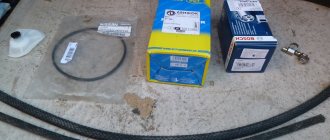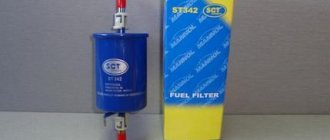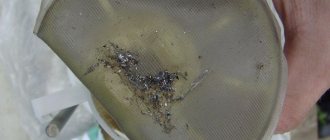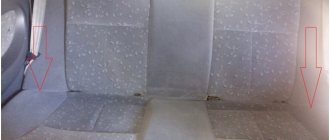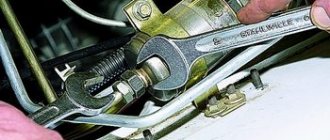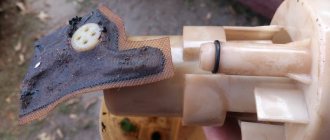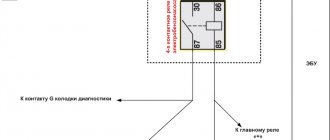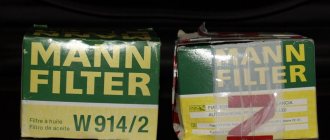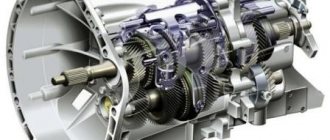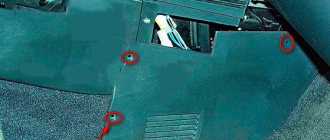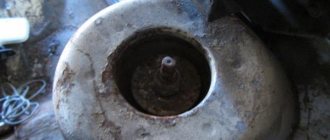Fuel filter Nissan Almera >
To prevent debris from entering the fuel line, the Nissan Almera Classic has fine and coarse fuel filters. They become clogged during operation, which does not have a positive effect on the throughput of the module.
When such a situation occurs, the load on the fuel pump increases and the stability of the engine is disrupted. To overcome this situation, it is necessary to replace the fuel filters. It won't be difficult to do it yourself.
Reliable replacement of the Nissan Almera N16 (H16) fuel filter and Nissan Almera fuel pump at a service station
Is it possible to drive without a fuel filter at all? – the answer to this question may surprise many owners of the Nissan Almera N16. It is possible, although not for long. Solid impurities contained in gasoline, entering the combustion chambers, will gradually settle in the form of soot on the pistons, valves and cylinder walls, which will ultimately damage the entire gas distribution mechanism.
But with a faulty filter element, that is, clogged to the point of complete obstruction, you won’t even be able to start the engine, because gasoline simply won’t get into the cylinders.
Is it necessary to replace the Nissan Almera n16 fuel filter: signs of malfunction
IMPORTANT! Some car owners, at the first sign of a malfunction of this element, in order not to waste time on a trip to a car service center, remove it from the fuel line - they say, I’ll install a new one when I have free time. But, as the Russian proverb says, there is nothing more permanent than something temporary: operating a car with a fuel system “modernized” in this way sooner or later turns into a tragedy. Replacing the Nissan Almera N16 fuel filter should be carried out at the first signs of engine starvation.
And these signs are:
- Difficulty starting the engine;
- The occurrence of interruptions in the operation of the motor. If its diagnostics did not reveal any failures in the electronic component, as well as the synchronization of the operation of the pistons and valves, the quality of the exhaust system and the failure of the lambda probes, then the reason for this most likely lies in the failure of the element we are considering. To be fair, we note that often interruptions in the operation of the power unit arise due to the quality of the fuel itself - its low octane number. So that's something to keep in mind as well;
- Significant drop in engine power. It is not surprising that by not receiving enough fuel, it reduces its efficiency;
- Unreasonable increase in gasoline consumption. Oddly enough, if the fuel purification element has poor permeability, the engine, losing power, begins to demand more and more of it and at the same time operate at higher speeds. The consequence of this is that higher gears have to be engaged at lower speeds than before;
- With all this, the engine often stalls, especially at low speeds when starting off. So, if at intersections your car every now and then stands rooted to the spot, then the reason for this should be sought in the quality of the work of the element we are considering;
- A significant decrease in the dynamics of the car - it accelerates much more slowly. This is especially noticeable on cars equipped with automatic transmissions. Of course, this symptom corresponds to a number of malfunctions, but coupled with those described above, it irrefutably indicates that replacing the Almera H16 fuel filter is the only way to get rid of the whole range of problems that have arisen;
- An incorrectly functioning fuel purification element creates additional load on the fuel pump, which may require replacing the fuel pump on the Nissan Almera H16.
Replacing the Almera N16 fuel filter wisely: design and functions of fuel filters on different types of engines
On a gasoline engine, this element is a durable, non-separable capsule in which the filter element itself is placed, made of micro-perforated parchment paper folded into an accordion. It is this that holds the smallest solid particles of contaminants. Unfortunately, such a filter is not capable of removing excess moisture from gasoline or raising its octane number.
But on diesel engines, the fine cleaning element performs several more functions in addition to this:
- Adsorbs excess moisture contained in diesel fuel;
- If necessary, it heats the fuel before feeding it into the combustion chambers so that the paraffin it contains does not settle on the valves, pistons and cylinder walls.
For this reason, on diesel engines this part has a significantly more complex design and, accordingly, a higher cost.
In addition, on the Nissan Almera N16, replacing the fuel filter with a diesel engine is a significantly more complex procedure. Here it will not be enough to remove the failed part and install a new one in its place - the operation of the diesel fuel fine cleaning element also implies its adjustment.
Article number and approximate cost of the branded fuel filter Nissan Almera Classic and its analogues
Coarse and fine filters are included in the fuel cup. They do not have their own article numbers and are not sold separately from the module. Therefore, it is impossible to purchase branded filters on Almera Classic without purchasing a complete glass.
The original fuel module has part number 1704095F0B. Its cost varies from 12,000 to 18,000 rubles. There are also analogues of the original glass on sale. The table below shows the best alternatives to the original fuel module.
Table - Analogs of the fuel module for the Nissan Almera Classic car
| Company manufacturer | Article number | Estimated cost, ruble |
| Messmer | 770065A | 2300-2700 |
| Bosch | 986580908 | 2800-3500 |
| Blue Print | ADG06819 | 2200-2600 |
| HKT | GIP522 | 2400-3000 |
| Krauf | KR7537M | 3200-4500 |
The fuel module has a very high price, so it is irrational to completely change it if only the filters are clogged. Therefore, car owners found a way out of this situation.
Despite the fact that the original fine filter is not available for sale separately, there are identical consumables for other machines from third-party manufacturers. The table below shows brands of fuel purifiers that are suitable for the Almera Classic car.
Table - Fine fuel filters for a Nissan Almera Classic car
| Brand | vendor code | Approximate price, ruble |
| SCT | ST399 | 300-350 |
| Japan Parts | FCH22S | 400-450 |
| Nipparts | J1330507 | 300-350 |
| AMP | FF0820 | 500-600 |
| Sakura | FS2813 | 720-1000 |
In addition to the fine fuel filter, third-party manufacturers also produce meshes. The most suitable consumables for restoring a glass are those presented in the table below.
Table - Fuel filter screens for a VAZ 2112 car with a 1.5 liter engine
| Firm | Catalog number | Approximate price, ruble |
| WEBER | 21121139200 | 55-100 |
| Cliff | 21121139200 | 95-120 |
| FARET | 21121139200 | 90-150 |
| Zommer | KRFS2112 | 130-210 |
| StartVolt | SFF0115 | 50-110 |
Fuel filter for Almera Classic – which one to buy?
The manufacturer does not provide for a separate replacement of the main fuel filter (as, in principle, other components of this fuel unit). Everything should only be changed as an assembly, as a whole module. Therefore, a separate article is not provided for both the filter and the mesh.
You can also install one of the analogs of the assembled module, since they are usually 1.5 - 2 times cheaper.
| Manufacturer | vendor code | price, rub. |
| Ruei | 2457 | 3600 |
| Cross | KN17-03055 | 6000 |
| ASParts | ASP2457 | 3700 |
Since replacing the entire module assembly at once is quite expensive, and is not always justified (since only the filter may become clogged, or the pump may fail, but everything else may be in good condition), many drivers often change the design of the unit, making a tie-in, and connect any remote fine fuel filter.
The second option for upgrading the fuel module is to install a fine filter from other fuel units that require its replacement. But for this, a cutout is usually made in the module body for the pressure regulator, since on all analogues it is located in a different place from the original.
In the table below you can see which fuel filter you can buy for the Nissan Almera Classic with the specified article number and price.
| Manufacturer | vendor code | price, rub. |
| SCT | ST399 | 300 |
| Japanparts | FCH22S | 370 |
| Hyundai/Kia | 319112D000; from Hyundai Elantra III (XD) | 1400 |
SCT ST399
Japanparts FCH22S
Hyundai 319112D000
As for the mesh filter, if necessary, you can simply wash it with a carburetor cleaner - Carb Cleaner. If a replacement is needed, then you can use one of the following analogues.
| Manufacturer | vendor code | price, rub. |
| Krauf | KR1111F | 100 |
| LADA | 1118-1139200 (from VAZ 2110-12) | 30 |
| Hyundai/Kia | 3109025000 | 340 |
When to change the fuel filter on Almera Classic?
According to the Almera Classic maintenance regulations, the manufacturer does not provide for replacing the fuel filter after strictly defined mileage periods. It is replaced as a whole, as an entire module, which in turn is designed for the entire service life of the pump. On average, the fuel pump becomes unusable between 100 thousand km and 200 thousand km.
If the fuel unit is upgraded independently (remote filter, or replaceable for collapsible modules), then it can be replaced every 45 - 60 thousand km. The filter mesh can be simply washed through one maintenance.
Fuel filter location
Coarse and fine filters on Almera Classic are part of the fuel module. The glass is placed inside the gas tank. To access it, you will need to remove the rear row of seats and open the access hatch.
Replacement interval and location of the fuel filter Nissan Almera N16
Dirty fuel filter
If we are talking about a car fueled with gasoline , then the fuel unit (assembly) must be replaced when the mark reaches 120,000 km . If the fuel is of poor quality, the interval should be reduced to 80 thousand .
An advantage will be the fact that the new fuel filter can be installed separately, i.e. without updating the module. As a rule, the mesh is left as old and simply washed.
If the Almera N16 has a diesel engine, change it after 30 thousand km .
Masuma MFF-T116
Almera H16 is equipped with two fuel filters - coarse and fine. The parts are installed in a single unit, which also includes a pump, float and sensors. The assembly (behind the cover) is accessible by removing the rear seat.
Frequency of replacing the fuel filter
The resource of the fuel filter directly depends on the purity of gasoline poured into the Almera Classic tank. On average, mesh replacement is required after covering 35-50 thousand km. The fine fuel filter lasts longer. It will become necessary to change it when the mileage exceeds 80 thousand km.
Symptoms of the need to replace the fuel filter are presented below:
- the car drives jerkily;
- the fuel pump operates with extraneous noise;
- starting the engine is difficult;
- Almera dynamics >Replacement of the fuel module and coarse and fine filters
Instructions for replacing the fuel module and fine and coarse gasoline filters are presented below.
- Remove the fuel pump fuse.
Changing the Almera H16 fuel filter
Problems with starting and operating the Nissan Almera H16 internal combustion engine can arise due to contamination of the coarse and fine fuel filters; problems also occur in the pump. Having decided to clean (replace parts of the fuel assembly), you need to prepare tools and materials. Namely:
- capacity (0.5 l);
- flathead and Phillips head screwdrivers;
- spanners;
- fire extinguisher (for safety);
- rags (the more, the better);
- acetone or carburetor cleaner.
Work should take place in a well-ventilated area away from sources of fire.
We pry up and open the plug, disconnect the power cable
For work you may also need: a vacuum cleaner, a hair dryer or boiling water, fuel hoses (can be bought from Russian cars), metal clamps.
We remove the fuel module from the tank
Replacing the fuel filter on a Nissan Almera N16 involves dismantling the module. You get it like this:
- Remove the seat cushion located at the rear. Pry off the cover with a flat screwdriver.
- We press the lock of the block with the wires , and move the block itself to the side.
- We relieve the pressure in the fuel system (start the engine, it runs until it stalls). Turn off the ignition.
- Squeeze the clamp and remove the fuel pipe from the fitting.
- We twist the clamping ring with a mounting spatula (you need to push the ring by the protrusions) and remove it.
- We remove the module from the tank. In this case, the float must be removed from the hole in the tank.
Disconnect the fuel line, unscrew the fastening ring, remove the gasket
Disassembling the fuel supply unit
The remaining fuel must be drained from the dismantled module . The open hole in the tank should be covered to prevent debris from entering.
Nissan recommends a complete replacement, but the filter can be removed and the mesh washed. Owners of Almera N16 also change the gasoline level indicator sensor and pump.
The analysis is carried out in this order:
Disconnect the fuel level sensor wires, disconnect the clamp and remove the fuel level sensor,
- We disconnect the block with the wires responsible for the operation of the sensor (on the back of the cover).
- Using the latch, we release the sensor itself , it is dismantled.
- a flat screwdriver to pry up the cup latches . The glass is detached from the body.
- Remove the mesh from the pump (you should pull it). We replace the part with a new one or wash it.
- The module cover is held in place by a latch, which we pry off with a screwdriver. The cover is moved to the side and the spring is released.
- We disconnect the wires from the pump and remove the part from the fuel filter to be replaced.
We disconnect the three latches, remove the glass, carefully with the small gasket, remove the coarse filter
We change the fine filter, connect the tubes and assemble
The Nissan Almera H16 pump has a corrugated plastic tube. To remove it, you need to pour boiling water over the tube. After this, it can be easily removed.
The tubes are easier to put on , but a new filter element is used if you use a hair dryer to warm it up . Softened plastic lends itself better.
A short tube goes at one end to the fuel pump, the other to the fine fuel filter. The long one goes to the pump housing cover, the other end also goes to the filter.
Press the cover latch, remove the cover and spring, disconnect the wires
It is important not to mix up the tubes and make the correct connection.
After updating the filter, the unit is assembled in the reverse order. When you return the cap to its place, the arrow on it should coincide with the mark on the fuel tank. The tube is put on the fitting, and a characteristic click of the clamps should sound. The tightness is checked with the ignition on.
We remove the fuel pump and disconnect the hoses
All about replacing the fuel filter on Nissan Almera Classic and N16
The fuel filter in the Nissan Almera Classic, as in any vehicle, is one of the main components of the fuel supply system. Its regular maintenance and replacement are a prerequisite for maintaining the car in good condition.
Where is the fuel filter located?
How to change it yourself?
Consequences of untimely replacement
Video “Replacing Fuel Filters”
Comments and Reviews
Fuel filter for Nissan Almera - self-replacement
Replacing the fuel filter on a Nissan Almera Classic must be carried out in accordance with the approved maintenance schedule. This element is constantly in contact with gasoline, which leads to natural wear of the material. Without this mandatory procedure, the efficiency of all vehicle components will decrease over time. At the same time, as the manufacturer indicates, for a Japanese sedan this part must be changed together with the fuel pump.
Where is the fuel filter located?
Fuel pumps on Nissan Almera Classic cars are located in a special removable module inside the fuel tank. These machines use a two-stage gasoline purification system.
It consists of two filters:
- the first one is intended for rough cleaning of fuel and is located at the inlet of the fuel intake module;
- the second - fine cleaning - is installed on the upper part of the fuel pump housing.
The location of the fuel filters and pump on the Nissan Almera H16 is absolutely identical to the location of these devices in the Nissan Almera Classic.
Layout of filters in the fuel pump module
The Almera G15 model is equipped with a simplified fuel filtration system, consisting of only one device for coarse cleaning.
Oil filter replacement process:
- Open the hood and unscrew the oil filler plug.
- Having previously placed a container for collecting waste under the drain hole, unscrew its plug.
- After draining the old oil, you should clean the seat of the drain plug, change the gasket on the plug if necessary, and then screw it into place.
- In order to get to the oil filter, you need to remove the engine protection.
- The old filter is unscrewed using a special wrench. If there is none, you can try to tear it off with a gas gun.
- We inspect the mounting hole and the filter gasket; if there is no damage, it can be reused on a new element.
- Pour a little clean engine oil into the new filter, and then lubricate its gasket with it.
- The new element should be screwed on and tightened only by hand, without applying excessive force.
- Next, fill in the required amount of new engine oil, checking its level using a dipstick, and close the oil filler cap.
- We start the power unit for a few minutes and turn it off. This is necessary to ensure that the oil is evenly distributed throughout the power unit.
- We monitor the oil level and top it up if necessary.
As you can see, there is absolutely nothing complicated in the process of replacing consumables on a Nissan Almera car, and timely implementation of the described procedures will increase the service life of the systems in the design of which they are included.
Replacement frequency
The manufacturer does not indicate the service life of the filter in the service manual for the vehicle. According to official Nissan documentation, its replacement is carried out only together with the installation of a new fuel pump. But car owners, given the unstable quality of gasoline in Russia, try to change filters every 90 thousand kilometers. Some car enthusiasts perform this procedure much more often - after 12–15 thousand km.
Sometimes there is a need to urgently replace the filtration device. Its signs may include dips and jerks during engine operation, especially when accelerating over 80 km/h. Engine “tripleting” may occur in different speed ranges.
Selecting a filter
Original fuel filters for Nissan are not available for sale separately. They can be purchased and replaced only as an assembly with a fuel pump. The part number for ordering the product is 17040–95F0B.
Analogs
As an analogue of the original filter mechanism for the fuel system of Nissan cars, they use devices from other automakers. Most often, a coarse filter from the Hyundai Accent (product code 31090–25000) or the domestic VAZ 2110–12 is used for this purpose. These parts, unlike the original, have a different shape for the installation part, which will have to be trimmed a little. From original spare parts, you will need a rubber ring to seal the module cover (17342–95F0A). Usually it has to be changed after damage due to careless dismantling of the cover.
The choice of fine filters is a little richer - this is the original part from Accent (article 31911–25000) or its SCT analogue with the number ST 399. These devices differ from the original Nissan filters in the location of the mounting point of the fuel pressure regulator. When installing them, you need to slightly trim the plastic body of the cup where the fuel pump is located. The installation of such elements has been repeatedly tested on Nissan cars produced in 2006, 2007 and 2008. For the Almera G15, the suitable filter is Francecar FCR 210141, which was successfully tested on a 2014 model.
Fuel filter on Almere H16
On the second generation Almera N16 with gasoline engines, as on most modern cars, there are 2 filters in the fuel system - the main one (fine filter) and the pump mesh filter (coarse filter). Both of them are located in a special fuel module, along with the fuel pump, sensors, and float. The module is placed in the fuel tank. To access it, you need to lift the rear seat and unscrew the cover.
The main fuel filter, unlike many other cars, which also have a module assembled with a pump, can be changed separately. It also differs depending on where the car is built.
| vendor code | Assembly location | Height, mm | Case diameter, mm |
| 164004M405 | Japan | 134 | 95 |
| 233000D020 (from Toyota) | Europe | 130 | 90 |
164004M405
233000D020
For a European-assembled car, the original part number for the filter is not provided, but a spare part from Toyota is used as a complete analog (indicated in the table).
The most popular analogues of fuel filters.
| Manufacturer | vendor code | price, rub. |
| For Almera H16 Japanese assembly | ||
| Masuma | MFF-N200 | 650 |
| Nipparts | J1331042 | 570 |
| For Almera H16 European assembly | ||
| Masuma | MFF-T116 | 1100 |
| LYNXauto | LF-998M | 1500 |
Replacement of fuel pumps is also common. For Japanese cars, the original article number for this part is 170424M400, for European cars it is 17040BN800.
The second generation Almera filter mesh does not have its own article number, since it comes assembled with the module, and when it gets dirty, it is usually simply cleaned. If cleaning does not help, they usually use a Hyundai Accent, article number - 3109025000, price - 340 rubles, or from Masuma - MPU-001, price - 270 rubles. Suitable for all versions of petrol Nissan Almera N16, regardless of the location of assembly.
Fuel filter for diesel Nissan Almera H16
On second-generation Almera with diesel power plants, fuel filters differ depending on the year of manufacture of the car. The diesel fuel filter was also different on the restyled version of the car with a 1.5-liter engine. In the original, they are always sold only assembled, along with a clamp, clamps and bracket.
| vendor code | Year of car manufacture | Height, mm | Case diameter, mm |
| 164005M300 | until 05.2001 | 137 | 94 |
| 16400BN30B | from 06.2001 | 153 | 97 |
| 1640100Q0D | restyling | 187 | 93 |
164005M300
1640100Q0D
This spare part is located on Almera N16 diesel versions under the hood, near the engine. As a general rule, it is common to buy one of the replacements, as they are only sold as an insert filter. Without brackets, clamps, etc., which is much cheaper.
| Manufacturer | vendor code | price, rub. |
| For Almera H16 with diesel engines until 05.2001 | ||
| MANN | WK 940/6 X | 1000 |
| Mahle/Knecht | KC67 | 650 |
| ...after 06.2001 | ||
| Mahle/Knecht | KC189 | 750 |
| Filtron | PP 857/1 | 520 |
| Restyled versions | ||
| SCT | ST 498 | 640 |
| MANN | WK 939/6 | 1400 |
How to change it yourself?
Sometimes car owners turn to an official dealer to replace Nissan Almera Classic fuel filters. But more often than not, many people prefer to do this work themselves.
Preparation
Before replacing the fuel filter, you need to prepare tools and auxiliary materials.
A short list of what you need:
- wrench 10;
- gas key;
- a screwdriver with a narrow flat and cross-shaped blade;
- cleaning agent (acetone, solvent or carburetor cleaner);
- an empty, stable container with a volume of 0.5–1.0 liters for draining remaining gasoline from the main line;
- rags for collecting spilled fuel.
Stages of work
After preparing the tool, you can begin work on removing and replacing parts.
- It is necessary to relieve pressure in the fuel system. To do this, you need to find the pump fuse in the mounting block, which is located under the instrument panel in the area of the driver’s left foot. It is marked on the diagram on the block cover as “fuel pump”. You should remove it from the socket. Then you need to start the car engine. It will run for a short time and then die. It is advisable to repeat this procedure several times with an interval of about a minute between starts. While the engine is running, open the filler neck of the gas tank to equalize the pressure with atmospheric pressure.
- Fold back the rear seat cushion, under which the tank is located. It has a mounting socket in which the fuel module is installed. Before removing the cover, it is advisable to wipe off dust and dirt around the socket. Using a 10 mm wrench or a Phillips screwdriver, you need to unscrew the three bolts securing the cover. Underneath there will be a cylindrical module made of white plastic with a black ring around its circumference.
- If the fuel pressure has not been relieved using the method described above, it can be lowered with the pump power connector disconnected. The procedure for starting the engine is similar. Then you need to install a container next to the drain module. By pressing the clamping ring, you need to pull off the fuel supply hose, previously wrapped in rags, and quickly throw it into the container. It is important not to spill fuel on the interior components, since gasoline will evaporate from them for a very long time. Up to 0.2–0.3 liters of fuel can leak from the line.
- Next, you should unscrew the module cover, which is secured with a ring nut (a black ring with protrusions around the perimeter of the module). The nut is tightened quite tightly and access to it is inconvenient. To unscrew, use the handles of a gas wrench. Now you can get the fuel pump module assembled with filters. In this case, it is important not to damage the float of the fuel level meter installed in the lower part of the device.
- You need to remove the top cover of the module by bending the three blade clamps with a flat screwdriver, and disconnect the connectors from the fuel level sensor and pump. Sometimes the wires may be held together with a nylon tie that needs to be cut off.
- After disconnecting the connectors, you can remove the pump with filters from the module housing. It is secured with three clamps that must be pressed while simultaneously pulling out the pump. The pressure regulator is located on the clamp and can be removed very easily. Then you need to clean the plastic cup of the module from the dirt accumulated inside.
- Next, an external inspection of the pump is carried out, as well as repair and maintenance of structural elements. The coarse filter is located on the bottom of the mechanism and can be easily removed by hand. The fine cleaning device is located at the top of the pump and is secured with two plastic clips. To bend them, use the tip of a flat screwdriver. When dismantling the filters, it is important not to forget to remove the cuffs from the pump fittings, which are installed in the new cleaning mechanisms.
- Then you can change the filtration devices and begin assembly in reverse order. In this case, you need to modify the pressure regulator valve by cutting its tube and extending it with an insert from a gas-resistant hose.
You can watch the procedure for replacing fuel filters in a video from user Azat Alikberov.
Action plan for replacing the Nissan Almera fuel filter
Determining that this filter has failed is not so difficult. It is definitely broken if, when driving at high speed (about 80 km/h or more), the Nissan Almera Classic engine starts to trip. It is strongly recommended to use only high-quality fuel, absolutely free from any impurities.
The fuel pump is located inside the tank. This machine has its own peculiarity, which is that the fuel pump mechanism is combined and inextricably linked with the cleaning filter. Carrying out this procedure at a service station will be expensive. If the problem is only in the filter, then you can try to clean it and replace the stack, which the developers do not recommend doing.
- Remove the cushion from the rear seat. We'll need to relieve the fuel pressure. To do this, you need to open the fuse box, located on the left side under the dashboard. Designations can usually be found on the cover; they will help you understand where the fuel pump fuse is located (according to the standard, it is designated “FUEL PUMP” and is fifteen-amp). We take out the required fuse and start the car without it. Afterwards the car will stall. You need to repeat these steps 2-3 more times until the engine stops starting. For the pressure to completely disappear, you need to maintain an interval of no more than 60 seconds between repetitions.
- We find the filler neck, remove the cap from it and relieve the internal pressure of the fuel tank.
- We take the necessary wrench, unscrew all the black bolts (by standard there are three of them, they are made of plastic, although in rare cases they can be made of metal). Then you need to remove the inspection hole cover.
- Having completed the previous operations, you should see a white container. And it should contain the fuel pump itself (it looks like a metal cylinder). Now we will remove the fuel filter itself.
Carefully remove the return hose while pressing the latch. You need to place an already prepared container under the hose. Approximately 300 ml of gasoline will leak out. You need to remove the second hose in the same way, but fuel will not flow from it. Be careful with the hoses so as not to accidentally damage them. Find the float for measuring the amount of fuel in the tank and the connector with the harness
They need to be disconnected, and then remove the pump assembly. Slowly and carefully disconnect the fuel hose. After removing the float and another sensor, remove the pump casing. At this point you should already get to the fuel filter. Your next steps depend on what you want to do:
- if you decide to do everything correctly, then install the new pump and filter in the reverse order;
- If you decide to only clean the gasoline pump, you can clean it or replace its old screen with a new one.
The entire structure must be assembled in reverse order.
If after performing this operation your engine does not start and you do not know what is wrong, contact your nearby technical service center for help.
Price issue
The cost of replacing the fuel filter on Nissan Almera Classic and N16 yourself can vary and depends on the manufacturer of spare parts. The price of the original pump complete with filters is about 10 thousand rubles.
The cost of non-original filters is much lower - for the entire set of parts you will have to pay about 1,700 rubles when using Hyundai devices, or about 800 rubles. for cheaper analogues. The most economical option is to replace the filter on a Nissan G15 - its price is around 120 rubles.
Signs of a clogged fuel filter
A clogged fuel filter is one of the main fuel pump malfunctions.
The characteristic signs of this problem include typical signs of pump failure:
- Difficulty starting the engine. The power unit does not start the first time.
- Rough engine operation at idle.
- Dips under increased load (when climbing or accelerating).
- Change in fuel consumption.
Where is the fuel filter for Nissan Almera N16?
The fuel filter on Almera, like most cars, is located in the gas tank. It can be accessed by removing the rear seat.
How much does a Nissan Almera N16 fuel filter cost?
According to official information, the filter on most Nissan Almera N16 cars is non-removable and must be replaced only together with the fuel pump. However, on cars of 2002-2003, filters similar to Toyota Avensis were installed. These are exactly what Almera owners install for themselves when they want to save money on replacing the pump.
The article number for such a fuel pump filter is 23300-0D020 ; you can buy it for an average of 1,500 rubles (the same as for a Nissan Tino). It is worth noting here that the price of analogues is slightly lower.
On the forums you can find messages from people who want to save money about installing a pump from a VAZ on a 2005 Almera.
The price of a complete fuel pump for Almera is about 11,000 rubles.
Consequences of untimely replacement
If the fuel filters are not replaced in a timely manner, at best, the car simply will not start, since the pump will not be able to supply gasoline to the injectors in the required quantity. In this case, there is a risk of pump failure, since it is fully cooled and lubricated only when pumping fuel. In the worst case scenario, small particles of dirt will travel along the fuel lines to the injection system injectors and clog them. Sometimes this clog can be so severe that it cannot be cleared. In this case, the parts must be replaced.
Where is the fuel filter located on Nissan Almera Classic?
There is a removable module inside the fuel tank. In addition to the fuel pump and pressure valve, it contains Almera Classic fuel filters. There are two of them, since the car uses a two-level fuel purification algorithm. The lower or coarse filter (mesh) is located in the place from where gasoline enters the fuel intake module. A thin filter is located at the top of the pump housing. It collects the smallest particles of dirt.
Instructions and photos for replacing the fuel filter on a Nissan Qashqai yourself
In a Nissan Qashqai, the fuel filter is located in the fuel pump, so in order to get to it, you will have to work hard and first remove this spare part from the tank.
To work you will need:
- screwdrivers;
- needle nose pliers;
- rags
- hammer and hacksaw for metal;
- filter element to replace.
Don't forget to relieve pressure in the fuel line.
The procedure should begin by removing the rear seat - the device we are interested in is located under it.
1.Use a screwdriver to unscrew the clips from the hatch found under the seat using a flat screwdriver in the direction of the arrows shown on it.
2.Under the removed cover there is a fuel line hose and a power connector. You need to turn off the power, open the tank lid and start the engine. This is necessary for the last fuel to burn out.
3.Drain the excess fuel from the tank and cover it with old rags or newspapers so that its remains do not splash everywhere.
4.Remove the collet crimp of the fuel line by pressing the release button firmly with a screwdriver. Unscrew the tank cap.
5. We take out the pump glass from it, disconnecting all the wires and hoses. It is important to pull out the pump with the filter element by tilting it so as not to break the float sensor.
6.Disassemble the pump. Remove the lower part by releasing the 3 clips.
7.Remove the fuel sensor by disconnecting the connector on top and from the gas tank.
8.Remove the fuel pump screen and clean it.
9.Disconnect the hoses from the filter. This is not very easy to do, they are filled with sealant, they rotate, but do not move. Using a hacksaw, you can saw off 2 fittings from the old filter.
10.Pull out the remaining fittings from the hoses with pliers.
11.Insert a new one in place of the used filter.
12.Assemble the pump and install it in the reverse order.
Finally, you need to start the car for a few seconds to allow the fuel to pass through the new filter element.
How often should the fuel filter be changed?
The manufacturer itself does not give specific dates, but recommends replacing filters along with the fuel pump. In Russia, owners of Nissan Almera Classic usually change both elements after 15-20 thousand kilometers, that is, more often than required, since they have to drive on low-quality fuel.
Sometimes there is a need to urgently replace filtration devices. You should be concerned when there are signs such as dips and jerks during engine operation. Dips are especially noticeable at speeds above 90 km/h. In this case, a tripping effect occurs when the motor operates in different ranges.
Fuel filter for Almera G15
1704200Q0G
The third generation of the car (Almera G15) does not have diesel engines, since only gasoline engines were installed.
On all trim levels with gasoline power units, a fuel module is installed, complete with a fuel pump. Only, unlike the previous generation, there is no separate replacement of the main fuel filter here, although it is possible to separate the module from the housing with the filter element. Therefore, there are no separate articles. The article number of the original module is 1704200Q0G, the price is 11,000 rubles. But, despite the fact that a separate replacement of the fuel filter is not provided, the drivers found a substitute that is similar in parameters and dimensions to the one built into the fuel module. Manufacturer Masuma MFF N229, price – 1100 rub.
There is also no separate article for the mesh filter on the 3rd generation Almera, since the manufacturer recommends immediately replacing the assembled module. But you can install an analogue. Usually they are from the same company Masuma, number - MPU025, price - 230 rubles.
When to change?
On petrol Nissan Almera, the manufacturer usually recommends replacing the entire fuel module assembly every 120 thousand km. But since the quality of the fuel is not always the highest, it is better to do this more often, at least every 80 thousand km. Moreover, on both generations it is possible to change only the main filter, while leaving the old module. The filter mesh can simply be washed with carburetor cleaner at each maintenance. On Almera with diesel engines, the filter needs to be changed every 30 thousand km.
Sources used:
- https://zapchasti.expert/toplivnyj-filtr/toplivnyj-filtr-nissan-almera-classic.html
- https://m.etlib.ru/blog/960-toplivnyj-filtr-dlya-nissan-almera-klassik
- https://autonissancar.ru/almera/almera-n16/menyaem-toplivnyj-filtr-almera-n16
- https://m.etlib.ru/blog/919-toplivnyj-filtr-dlya-nissan-almera
Which filter should you choose?
Original filters are not sold separately. You can only buy the part together with the pump module. There are many analogues. Some even install filters from our “ten” or VAZ-2112. However, in the latter case, you have to slightly modify the installation part. Sometimes you also need an original cuff to seal the module cover. This component is damaged if the cleaning devices are not removed carefully.
Branded trainers from Hyundai Accent can also serve as substitutes. They differ from the original. In particular, this concerns the location of the mounting points of the pressure regulator (valve). The element will fit as desired if you lengthen the valve using a hose or slightly trim the module shell.
Which filter element should I buy?
The fuel filter on Almera N16 cars, despite its location (in a single module with a pump), can be changed separately . Of course, you can replace the assembly. Cars have different filters (depending on the assembly - Europe, Japan).
Nipparts J1331042
The article number for the original part for a Japanese-assembled is 164004M405 . On Almera N16 of European assembly - 233000D020 (analogue from Toyota), i.e. The original article is not here.
The following analogues are also installed on the Nissan Almera N16:
- Masuma catalog number MFF-N200 and Nipparts article number J1331042 - for Japanese assembly;
- Masuma MFF-T116 and LYNXauto LF-998M - for European Almeria.
Fuel pumps are also being changed. The catalog number for the “Japanese” is 170424M400 , the European version of the pump is 17040BN800 .
Fuel filter 233000D020
As for the mesh, there is no original article for it. Cleaning the mesh filter is sufficient to restore performance. If flushing does not produce results, you can install a consumable from Hyundai Accent (article 3109025000 ) or a Masuma brand part (MPU-001) on Almera N16. The plus is that the mesh will fit on Almera N16 of any build.
Fuel pump
Replacement procedure: step-by-step instructions
Before performing operations, you need to prepare the following tools:
- set of wrenches;
- spanning tool (gas wrench);
- wire cutters, pliers;
- a set of screwdrivers with different tips;
- rust removers (solvent, carb cleaner);
- an empty 1-liter container for draining remaining gasoline from fuel lines;
- clean rag.
Work on removing elements must be carried out strictly sequentially. First you need to relieve the pressure in the car's fuel system. The fuse responsible for the operation of the pump must be removed from the mounting block under the instrument panel in the car interior. In the diagram it is marked as fuel pump.
The sequence of actions is as follows:
- Pull out the fuse.
- Then start the engine.
- Open the oil filler cap.
- Wait until the engine stops on its own.
The procedure must be repeated 2 more times with an interval of 1 minute.
Further actions are carried out inside the car. Need to:
- Raise the rear seat of the car.
- Find the hatch containing the fuel module.
- Wipe thoroughly around the nest cover so that no dirt or dust remains (otherwise, when opening it, it will get inside, and this is undesirable).
- Unscrew the cover fasteners using a screwdriver or wrench.
- Disconnect the pump by removing the power connector.
- Start the engine and wait until it stops.
- Pressing the latches, sharply pull out the gasoline supply hose.
- Wait until the remaining gasoline flows out of the line.
To prevent fuel from spilling and staining everything around - the smell of gasoline may not disappear from the car for a long time - you need to place an empty container near the module (a white plastic case with a lid-rim around the circumference) and lower the fuel supply hose into it.
Now we move on to the stage of removing the module. Need to:
- Unscrew the locking ring of the module using a socket tool.
- Remove the fuel module, working carefully. The fact is that at the bottom of the device there is a float for the gasoline level sensor. If you rush, it can be easily damaged.
Many people simply use a gas adjustable wrench, which is taken by any protrusion of the clamp and rotated counterclockwise. In general, the retaining ring is tightened very tightly and access to it is inconvenient. Therefore, it is not always possible to work with a gas wrench (especially if it is large). But using its handle as a stop is another matter. You need to rest the handle against the lower part of any protrusion on the right, then press or lightly hit it with a hammer. You can also use 2 handles, grabbing the key from above and applying more force. You cannot use a chisel as a stop (as some would-be masters recommend doing)!
Next, work is carried out to disassemble the module:
- Remove the top cover by bending the petal-type clamps. To do this, use a flat-tip screwdriver.
- Disconnect the connectors from the regulator (level sensor). Sometimes the wiring can be pulled together with a rigid scraper. It needs to be cut off with wire cutters or pliers.
- Press 3 clamps at once to pull up the fuel pump with both filters from the plastic housing of the module.
- Disconnect the pressure sensor - it is easy to pull out, since it is held on a clamp.
- Thoroughly clean the interior of the case using a cloth. It is recommended to soak the tip in acetone or gasoline.
The pump should be thoroughly inspected for damage. The coarse filter is located at the bottom of the device; the mesh is simply removed by hand. But the fine cleaning element is attached using plastic clips. They should be carefully pressed with a flat screwdriver so that the filter is released and comes out.
Next, reassembly into the tank is carried out. A new original Nissan fuel module (approximate price - 15 thousand rubles) or a filter from a third-party manufacturer is installed. It is important not to forget to replace the original cuffs of the fittings.
Detailed description of replacing the fuel filter and fuel pump
Replacing the Almera Classic fuel pump and filter must be performed in a sequence that will be discussed in detail below. The work will be carried out in three stages: extraction, disassembly and reinstallation.
Required parts and tools
The gasoline pump and filter components are replaced with the following tool:
- gas key
- set of open-end and ring wrenches
- pliers
- Phillips screwdriver and flat blade.
Replacing the Almera Classic fuel filter
You also need to prepare spare parts:
- coarse and fine filter
- fuel pump
- fuel tank flap gasket – 17342-95F0A
- hoses resistant to oil and gasoline, as well as clamps for fixing them
- rags
- solvent
- container for receiving remaining gasoline from the system.
Filter elements and a gasoline pump are selected according to the previously presented articles.
Removing the fuel module
Before dismantling the Almera Classic fuel module, it is necessary to completely relieve the gasoline pressure in the car system. To do this, repeat the following procedure three times at intervals of several minutes:
- Remove the fuse from the interior mounting block, which is responsible for the fuel pump;
- Start the Nissan Almera Classic engine;
- Wait until the engine stalls.
In the future, you will need to move into the car interior and perform the following steps:
- Fold down the lower part of the rear sofa;
- Clean the hatch cover and the area around it from dirt and dust;
- Remove the hatch cover by unscrewing the fasteners;
- Disconnect the supply cable from the fuel pump;
- Start the engine, wait until it stalls;
- Place the container, loosen the clamp of the fuel supply hose, remove the hose and lower it into the container. Wait until the remaining gasoline drains out.
Now you can proceed directly to dismantling the fuel module.
- Using the handles of the gas wrench, unscrew the locking ring of the module. It is necessary to rest them against special plastic protrusions, applying force in a counterclockwise direction;
- Carefully remove the module so as not to damage the fuel level sensor float
Let's sort it out
We begin disassembling the Almera Classic fuel module. It is recommended to follow the following sequence of actions:
- Using a flat blade screwdriver, press out the three plastic clips to dismantle the lower housing;
- The supply wire is disconnected from the gasoline level indicator;
- Holding three clamps, the pump and Almera Classic filter elements are removed;
- By loosening the clamp, the pressure sensor is disconnected;
- Use a rag soaked in solvent to wipe the internal cavity of the housing;
- The condition of the fuel pump, coarse and fine filters is assessed. The first is located at the bottom of the device and can be removed by hand. The second is secured with plastic latches, which should be released using a flat-head screwdriver;
- We compare prepared spare parts by size;
- All sealing rubber bands are removed from the fine filter.
Dirty coarse filter
Installation of a new fuel pump, filters and assembly
The process of reassembling the Almera Classic fuel supply system begins with the installation of sealing gaskets in the fine filter. Then:
- The fuel pump and fine filter element are mounted in its seat;
- Depending on the prefilter, it may be difficult to install. They are due to the presence of two plastic protrusions that prevent the element from being fixed to the fuel pump. Therefore, you will need to grind them off with a file;
- On the pressure sensor you will need to cut a suitable pipe, cutting off the curved part;
- When installing the pressure sensor into the seat, you will need to break off part of the fuel receiver housing, which will interfere with installation;
- We use an oil and gasoline resistant hose to connect the parts of the previously cut fuel pressure pipe. In this case, it is necessary to secure both ends of the hose with clamps. The sensor is secured using the original clamp;
- We install the lower part of the fuel module in place, having previously lubricated the fuel supply pipe. This will allow you to align the tube with the sealing rubber bands without excessive resistance.
All that remains is to install the module in its seat in the reverse order. Do not close the hatch cover until the fuel system is checked. To do this, start the engine and if everything is in order, then turn off the engine and screw the cover into place.
